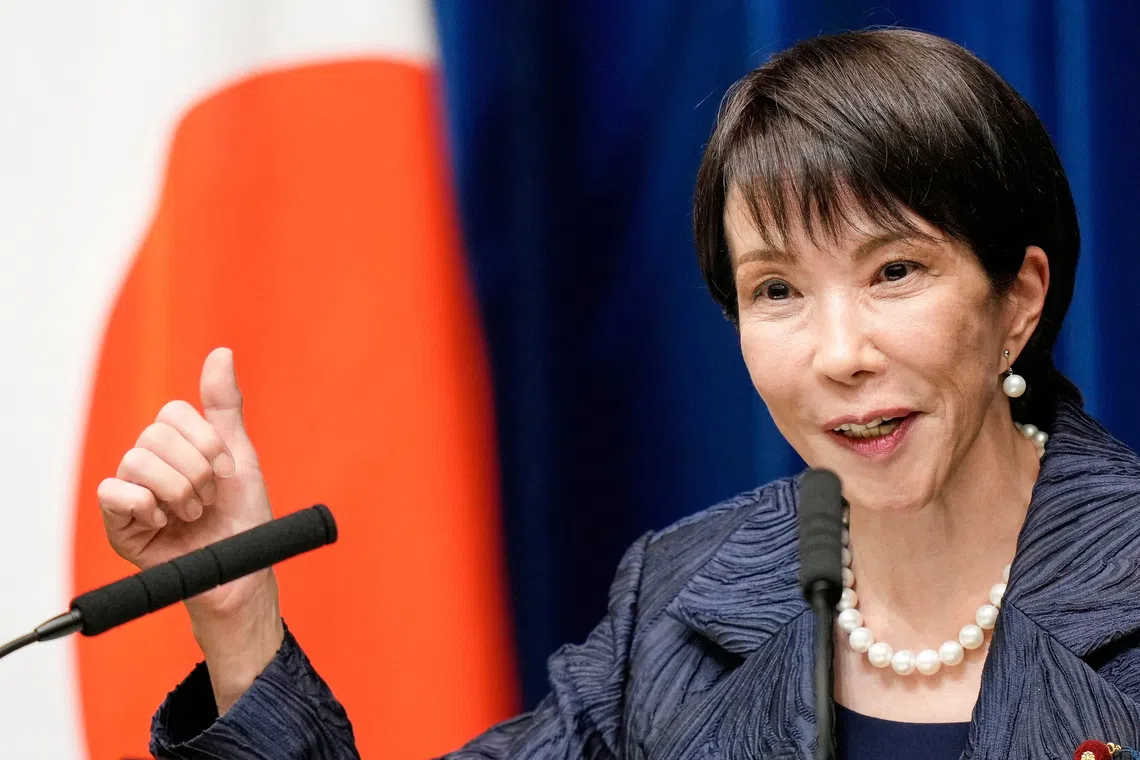Japan’s Takaichi faces early test of defence ambitions with Trump visit
Sign up now: Get ST's newsletters delivered to your inbox

Japan's new Prime Minister Sanae Takaichi speaks during a press conference at the prime minister's office in Tokyo, Japan, on Oct 21.
PHOTO: REUTERS
Follow topic:
TOKYO - Japanese leader Sanae Takaichi’s new hardline coalition partner unshackles her security ambitions and gives US President Donald Trump room to press for military spending, but her fragile government may put a brake on what she can do.
Ms Takaichi, an admirer of conservative British Prime Minister Margaret Thatcher, was sworn in on Oct 21 as head of a government
“She is conservative, wants to increase defence spending, and has styled herself the Japan First candidate. If she has a vulnerability with Trump, it is her relative weakness at home,” said Professor Michael Green, head of the United States Studies Centre in Australia and a former senior US National Security Council official.
Ms Takaichi has only a few days to prepare for her first face-to-face talks with Mr Trump since becoming Japan’s first female prime minister on Oct 21. They may cross paths at the Asean regional bloc summit in Malaysia on Oct 26 before holding formal talks in Tokyo early next week.
“She certainly will be experiencing a baptism of fire on the diplomatic front,” a senior US diplomat told Reuters, asking not to be identified because he is not authorised to speak publicly.
Unshackled by move to partner Ishin
A follower of assassinated Japanese premier and Trump confidant Shinzo Abe, Ms Takaichi ended the ruling Liberal Democratic Party’s 26-year coalition with the pacifist-leaning Komeito, replacing it with the right-wing Japan Innovation Party, known as Ishin.
“Komeito always served as a brake and now you have two coalition partners that are pretty much aligned,” said Dr Jeffrey Hornung, an expert on Japanese security policy at the Rand Corporation.
The shift frees Ms Takaichi to push Abe-era security reforms further.
Like her, Ishin wants to revise Japan’s pacifist constitution, strengthen the military to deter China and loosen restrictions on arms exports.
Ishin has even floated a US-style nuclear-sharing deal that would give Tokyo a say over any US weapons deployed in Japan. That would be a radical departure from Japan’s long-held three non-nuclear principles of not developing, deploying or hosting such weapons.
Ms Takaichi has signaled she will accelerate Japan’s largest military buildup since World War II, doubling defence spending to 2 per cent of gross domestic product. She has said a “contingency” in Taiwan, which Beijing says must eventually be reunited with the mainland, would be a contingency for both Japan and the United States.
“Managing relations with China will be a major hurdle for her,” said Mr Kenji Minemura, a senior research fellow at the Canon Institute for Global Studies. “The loss of Komeito, which maintained ties with Beijing, is another setback.”
The upcoming Trump meeting gives Ms Takaichi a chance to outline her regional security goals before Mr Trump meets Chinese leader Xi Jinping next week ahead of the annual Asia-Pacific Economic Cooperation summit in South Korea.
Reliance on opposition parties for support
Her political weakness, however, will limit how much she can promise Mr Trump on defence spending, said Tokyo University professor Ryo Sahashi.
“Speeding up the buildup was always on the cards, but the real issue is the budget,” he said. “It’s doubtful a government with such a weak footing can decide to jump to 3 per cent.”
While Ms Takaichi won enough votes to become prime minister, her bloc will still have to shop around for opposition support to pass key Bills, a challenge Mr Abe never faced.
“If Trump pushes her for a specific number, it could cause early friction,” said Dr Hornung. “It wouldn’t surprise me if he says, you’re an ally, you need to do 3 per cent, even 5 per cent.”
To win Mr Trump’s favour, which could bolster her standing at home, Ms Takaichi instead plans to present a package of US purchases, including Ford F-150 pickup trucks, soybeans, natural gas and a list of potential US investments, sources earlier told Reuters.
While Ms Takaichi and the LDP will miss the presence of Mr Abe, who was assassinated in 2022, his widow Akie will be there to meet Mr Trump. Ms Takaichi’s officials may even take the US leader to the golf course he and Mr Abe played at in 2019 during his last visit, local media reported. REUTERS

